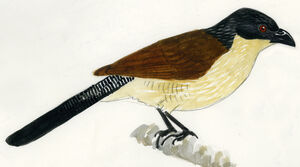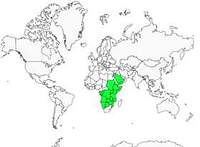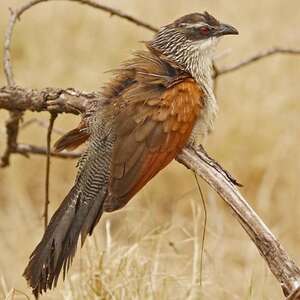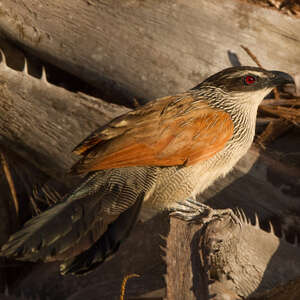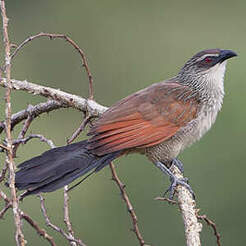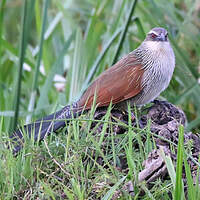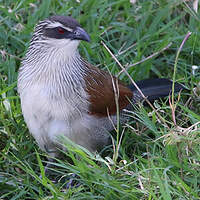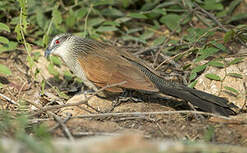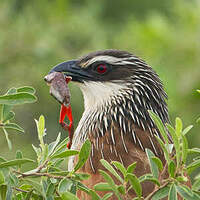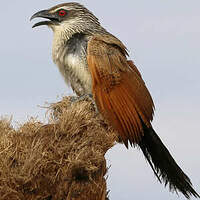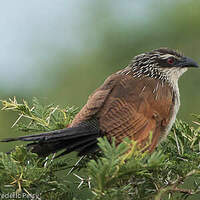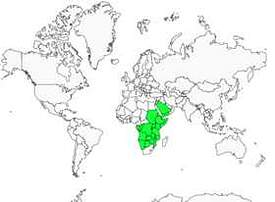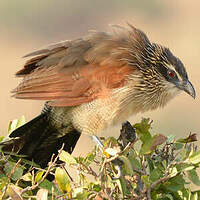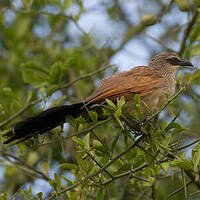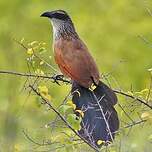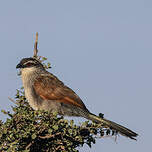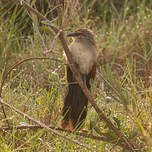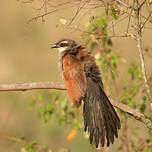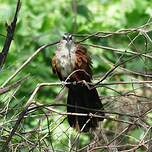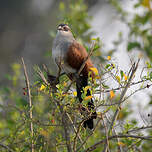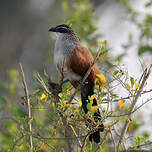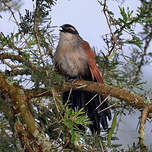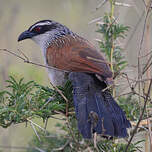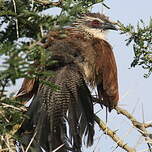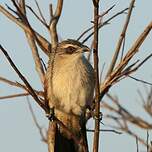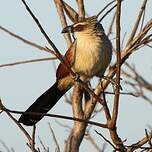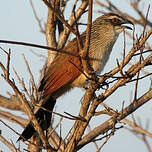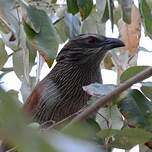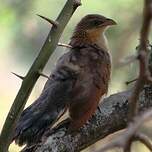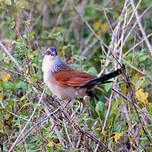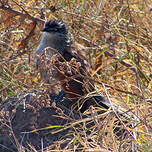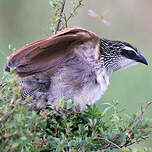White-browed Coucal
Centropus superciliosus - Coucal à sourcils blancs
Identification
As with most Cuculidae, sexual dimorphism is little to none, the female is only slightly larger than the male. In the adult of the nominate subspecies, the head is blackish-brown with a distinct white eyebrow. Against this dark background, creamy-white longitudinal streaks spread across the nape, cheeks, throat and upper chest, making the chin and throat clear. It looks very good. The mantle, back, wing coverts and tertial remiges are rufous-brown. The other remiges are vivid orange, which can be seen clearly in flight. The rump and the upperscans are black, finely barred with white and the rectrices are shiny black with greenish reflections. The undersides are pinkish-white, finely striped on the sides and the underside. The iris is reddish-brown. The powerful and curved culmen beak is black. The legs are blue-black. The juvenile is much less contrasted. The top of the head is brown, the iris is white and the beak is not really black. The upper parts are warm brown and barred with red on the wings. The pale streaks are discreet and very few. The cheeks and all the undersides are washed in red. In the south of the continent, the adult has a different appearance. The pale streaks are much less present. The cap, cheeks and nape are frankly black and the black extends a little on the mantle.
Subspecific information 2 subspecies
- Centropus superciliosus superciliosus (sw Arabia, Socotra I., e Sudan to w Somalia, n, c and e Kenya, ne Uganda and ne Tanzania)
- Centropus superciliosus loandae (Uganda and sw Kenya to n Zimbabwe, Botswana and Angola)
Foreign names
- Coucal à sourcils blancs,
- Cucal cejiblanco,
- cucal-de-sobrancelhas,
- Weißbrauenkuckuck,
- szemsávos bozótkakukk,
- Wenkbrauwspoorkoekoek,
- Cucal cigliabianche,
- vitbrynad sporrgök,
- Hvitbrynsporegjøk,
- ostrohár tiputip,
- kukačka bělobrvá,
- Hvidbrynet Sporegøg,
- puputtajakukaali,
- Gestreepte Vleiloerie (Witbrouvleiloerie ),
- cucal cellablanc,
- kukal białobrewy,
- baltaču koukals,
- Белобровый кукаль,
- マミジロバンケン,
- 白眉鸦鹃,
- 白眉鴉鵑,
Voice song and call
The sounds emitted by the White-browed Coucal are quite difficult to localize due to it vocalizing inside thickets or bushes. However, it is well-known for its call that sounds like pouring water out of a bottle. It communicates through short or long calls. The short calls are deep notes emitted without any change in the rhythm. The notes in the long calls have been described as resembling the sound of water pouring into a jar. More rare than the short calls, they are often emitted by the couple. In cases of alarm or distress, to protect its nest, it emits short and repeated calls: Khhuh or Guk... Chattering is also frequent. It is expressed through long series of guttural notes with a rhythm of five seconds or more, beginning at a quick rate and then slowing down until the end of the phrase.
Habitat
The White-browed Coucal primarily inhabits areas of wet vegetation, and is mainly found in low-altitude lands where it occupies riverbanks, marshlands, and their surrounding habitats; tall grasses, thickets or dense bushes. It is encountered to a lesser degree in mountain areas up to 2,200 metres or even 2,800 metres in arid regions.
Behaviour character trait
The White-browed Coucal resides in its range year-round. While it calls with a rather grave voice in dense vegetation, it also loves to perch on the top of bushes or clear branches while chatting or calling out.
These are moments of exhibitionism: neck stretched out and head leaned forward, beak pointed to its chest, it inflates and deflates the sides of its neck while its body shakes to the rhythm of its calls. The calls and vocalizations suggest a role of defence in territoriality but also are there to reinforce the bond of the couple. The White-browed Coucal vocalizes year-round, with a peak during the breeding season, more prominently early morning and late afternoon. It can occasionally be heard at night. It is a monogamous species.Dietfeeding habits
The White-browed Coucal predominantly feeds on insects, particularly grasshoppers, crickets and locusts, by spending lots of time on the ground or inspecting tall grasses in wetlands. It also takes advantage of the opportunity to grasp spiders, snails, lizards, snakes, frogs, small mammals, and even small birds including nestlings and eggs.
Reproduction nesting
The White-browed Coucal breeds all year round, depending on its distribution zone. Prior to mating, the female will be offered a large insect by the male.
She builds her nest in reeds or inside the bushes. In the form of a large dome with a lateral entrance, it consists of mixed up herbs and twigs mixed and lined with leaves. She lays 3 to 5 white eggs every 24 to 48 hours, sometimes more. The incubation lasts 14 to 15 days and begins with the laying of the first egg; it is largely executed by the male. The chicks are black with a long white down. The feeding of the young is done by both parents.Geographic range
The White-browed Coucal is the most representative of the genus in a large part of Africa. It is sedentary there. Its distribution mainly covers East Africa, Southern Africa, as well as some points in Gabon and Congo. It can also be found in the extreme southwest of Saudi Arabia and east of Yemen.
Threats - protection
Sources of information
- IOC World Bird List (v15.1), Gill, F and D Donsker (Eds). 2025-12-07.
- Birds of East Africa: Kenya, Tanzania, Uganda, Rwanda, Burundi, Terry Stevenson, John Fanshawe
- Birds of the World, The Cornell Lab of Ornithology
- eBird, Cornell Lab of Ornithology et National Audubon Society
Other sources of interest
 Specification sheet created on
18/07/2023 by Nathalie Santa Maria
Specification sheet created on
18/07/2023 by Nathalie Santa MariaTranslation by AI Oiseaux.net
© 1996-2025 Oiseaux.net
- Accipitriformes
- Aegotheliformes
- Anseriformes
- Apodiformes
- Apterygiformes
- Bucerotiformes
- Caprimulgiformes
- Cariamiformes
- Casuariiformes
- Charadriiformes
- Ciconiiformes
- Coliiformes
- Columbiformes
- Coraciiformes
- Cuculiformes
- Eurypygiformes
- Falconiformes
- Galliformes
- Gaviiformes
- Gruiformes
- Leptosomiformes
- Mesitornithiformes
- Musophagiformes
- Nyctibiiformes
- Opisthocomiformes
- Otidiformes
- Passeriformes
- Pelecaniformes
- Phaethontiformes
- Phoenicopteriformes
- Piciformes
- Podargiformes
- Podicipediformes
- Procellariiformes
- Psittaciformes
- Pterocliformes
- Rheiformes
- Sphenisciformes
- Steatornithiformes
- Strigiformes
- Struthioniformes
- Suliformes
- Tinamiformes
- Trogoniformes

